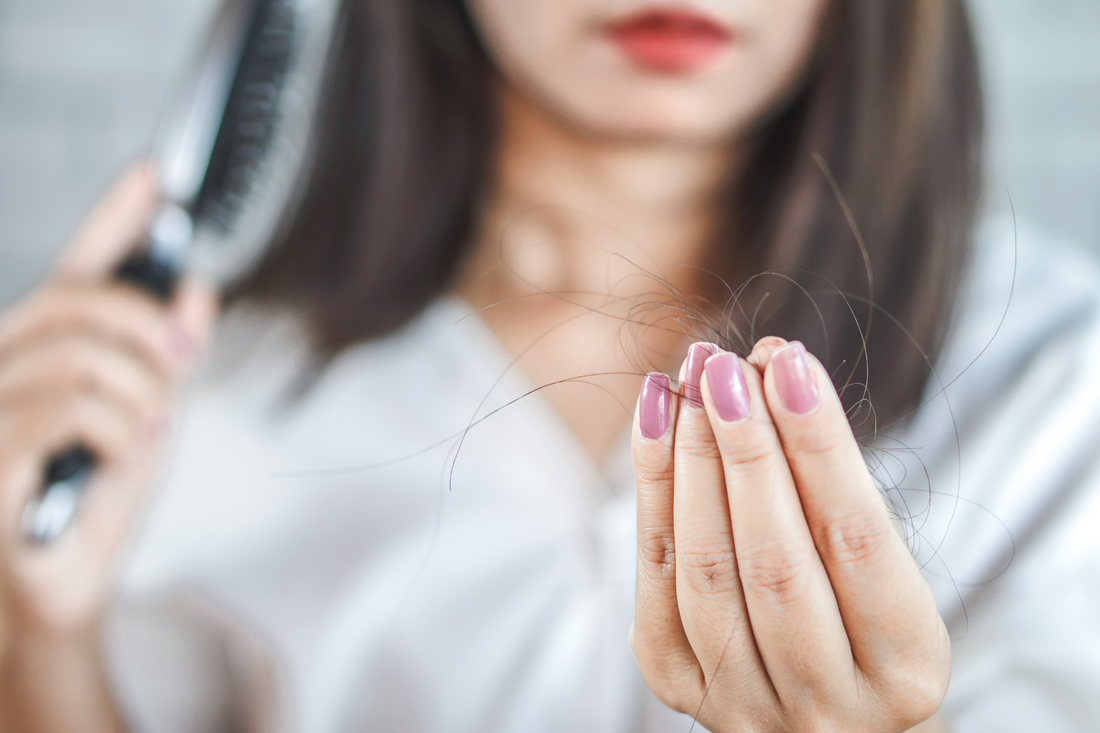Female hair loss is an issue for 50% of women by the age of 50. If you’re worried about thinning hair -or if you shed more than 125 strands of hair per day- being informed on the symptoms and causes of hair loss will help resolve the physical and emotional challenge of hair loss.
What is Female Hair Loss?
Before we go into the details of what causes female hair loss, it's important to understand what it is. Female hair loss can be broadly bundled into three types:
- Anagen effluvium
- Telogen effluvium
- Androgenic alopecia
Anagen Effluvium hair loss is typically an abnormal, rapid loss of hair caused by medications that harm your growing hair follicles and is most commonly seen in situations with chemotherapy.
Telogen Effluvium hair loss is when stress results in an excessive number of your hair roots to enter a resting phase. Normally, 5-10% of your hair is in the resting phase, but in Telogen Effluvium it can get as high as 70%. This can be caused by sudden shocks to your system caused by highly stressful events. Telogen Effluvium induced hair loss typically is noticed several weeks to several months after the event.
Androgenic Alopecia is more commonly known as Female Pattern Hair Loss (FPHL). FPHL is the thinning of hair in women often caused by increased hair shedding or reduction in hair volume. This occurs in 40% of women by age 40.
Female Hair Loss Causes
This is often caused by your hair follicles shrinking and eventually stopping hair growth. If genetically caused hair loss is addressed early, treatment may stop shedding and help with new growth.
As you grow older your hormones change, which can play a big role in potential hair loss. This type of hair loss tends to be more significant during menopause when your estrogen levels start decreasing. If this type of hair loss is caught early, treatment may be able to help with hair loss.
As mentioned with Telogen Effluvium, high stress events can cause hair loss due to an excessive amount of your hairs entering the resting phase. Regrowth is definitely a possibility, but only if the stress is stopped. Once stress is stopped, most people can see their hair regrowth within half a year to nine months.
Coloring, perming, or relaxing your hair can damage your hair and result in hair loss or hair thinning. Regrowth is possible if more gentle methods of styling are used. If hair damage is significant, it might be difficult to encourage new growth.
Hair that is constantly pulled back in tight styles can result in permanent hair loss known as Traction Alopecia. This occurs if you wear your hair in a tight ponytail bun, braids, or you use chemicals/heat on your hair. Caught early, hair can regrow from this situation, and is even fully irreversible. But if the hair follicle is permanently damaged, then hair cannot grow out of it anymore.
Diagnostics
If you’re worried that you may be experiencing female hair loss, gently pull on your hair to see how much hair comes out. If a bundle of hair or significant amounts of hair come out, your next step should be to go to a dermatologist. A dermatologist can then help examine your hair and scalp for a medical diagnosis.
Future steps may include:
- Blood tests to check your vitamin levels (for example, Vitamin D and Iron), and hormone levels (for example, thyroid and sex hormones)
- Scalp examination using a microscope or trichoscope to assess your hair density and hair thickness
- Scalp biopsy to remove a small piece of your scalp skin to assess it
Potential Questions You’ll Be Asked:
- What hair products you use
- What hairstyles you wear
- Your family hair loss history
- If you have experienced any stressful events recently
- How long you have been losing your hair
- If you take any medications
- What types of food you eat
Treatment
If you're experiencing female hair loss, it's important to get to the root of what is causing your symptoms. Different types of hair loss can be managed through different remedies and methods, so it's important to understand your medical history and reflect on recent psychological or physical stressors.
Treatment for female hair loss can vary depending on the cause of hair loss. In the case of FPHL (Female Pattern Hair Loss), which is genetic, the dermatologist might recommend something like Minoxidil. Minoxidil is available either as a foam or solution and applied directly to the scalp. And although it is currently unknown the exact mechanism for how the medication works, if hair growth is to occur it should be after several months of usage. It is important to note that Minoxidil will only help with hair growth for as long as it is applied (if it works for you).
While Minoxidil has been a leader in the hair growth industry for some time, it is not a universal solution. Keep in mind that Minoxidil was originally discovered in the 1950’s to treat high blood pressure. It was officially approved as a drug for hypertension by the Food and Drug Administration (FDA) in 1979. After conducting a few studies, scientists began to notice an unexpected side effect of taking the product was an increase in hair growth.
At Revela, we dedicate our time and use of technology to help find and optimize new ingredient(s) to help with growing hair – something we dare say that no other company is currently doing. We recommend that you try the Revela Hair Revival Serum, which harnesses the power of new, targeted ingredients to support hair follicle health and helps to reduce the appearance of thinning hair.




